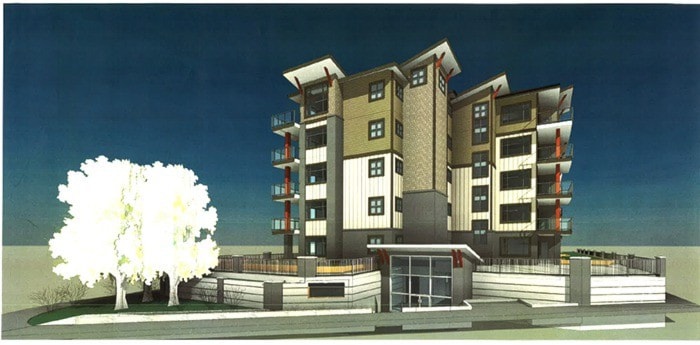Much like the dance for which it was named, the proposed Charleston building in Langley City has fallen out of favour.
On Monday night it became official — the City’s first proposed highrise condominium project, announced with great fanfare two and one-half years ago, will not happen.
Instead, City council has approved a new development permit for a five-storey, wood-frame condominium complex on the property, located at the corner of 203 Street and Industrial Avenue.
Unlike the Charleston, the new design does not include commercial space, nor will it incorporate a Roaring ’20s design.
Accompanied by project owner-developer Walter Fritz, Wes Friesen of Points West Architecture presented council with highlights of the new building’s “West Coast” design.
The building’s 78 units, some of which will include vaulted ceilings, will range in size from 600 square feet to 1,600 square feet, with the largest located on the fifth or ‘penthouse’ floor, Friesen explained, adding they will be accessed by one high-speed elevator.
In response to a question from Councillor Dave Hall about whether a second elevator had been considered, Friesen said that would normally only be the case in a building with more than 80 units.
In addition to using up salable floor space, a second elevator would cost an additional $100,000, he explained.
Because the number of units is at the high end for one elevator, however, the decision was made to install a high-speed lift. Although more expensive than a regular elevator, it represented a compromise, Friesen said.
Hall also noted that at five storeys, the wood frame building will be safer than many existing structures, because it will be required to have sprinklers in the attic space and on balconies, in addition to inside the units and public areas.
At the same time, he expressed disappointment that the design does not include an allowance for commercial space.
“It’s an area (of the City) we would like to see develop comprehensively,” said Hall. “It’s a bit of a loss, but I think we have to be realistic about what the proponent can accept.”
Unveiled in front of a large crowd at City Hall in April 2012, the Charleston, a 15-storey building which featured a 1920s art deco design, was scheduled to be complete sometime in 2015.
The bottom six floors were to include space for office and retail, with an additional nine-storey tower of residential units rising above a roof garden.
However, following the announcement, the lot which had been home to a nightclub, sat empty and untouched for months after the bar closed. The building was finally demolished in July.
In November 2013, after a long period of time had passed with no visible progress on the site, The Times asked then-developer David Phan what was holding up the project.
He cited the proposed relocation of the City’s bus loop — possibly to property on the east side of 203 Street — and the potential effect the resulting new traffic patterns would have on the Charleston’s property line, as the reason for the delay.
On Monday, soil conditions — specifically, the prohibitive cost of driving piles through clay far enough to reach bedrock to support the structure — were blamed.
No mention was made during the presentation about whether the highrise building’s marketability factored into the decision to change the design. However, Fritz acknowledged before the meeting that the Charleston wasn’t a good fit for the location, while stressing that the new project will still be a high-end development.
Council voted unanimously to approve a development permit for the new, scaled-down project, with some members expressing relief that the project will finally go ahead.
“A lot of people, including council, will be glad to see that hole filled,” said Councillor Gayle Martin, who called the new rhombus-shaped design “very attractive.”
Acting Mayor Ted Schaffer praised Fritz for forging ahead with the project, “after pouring millions of dollars into the original design, which was basically a wash.”
